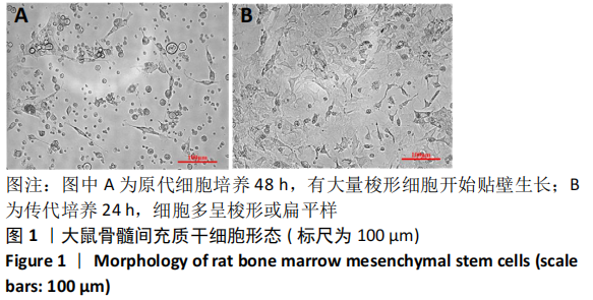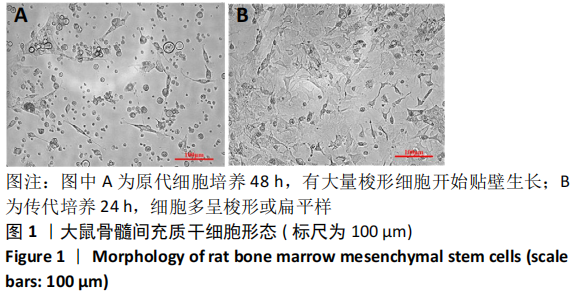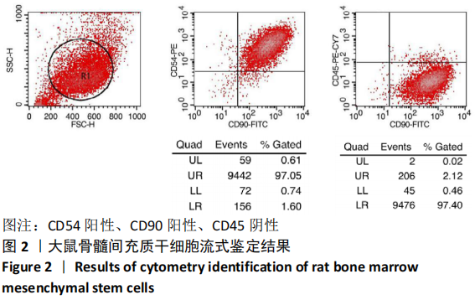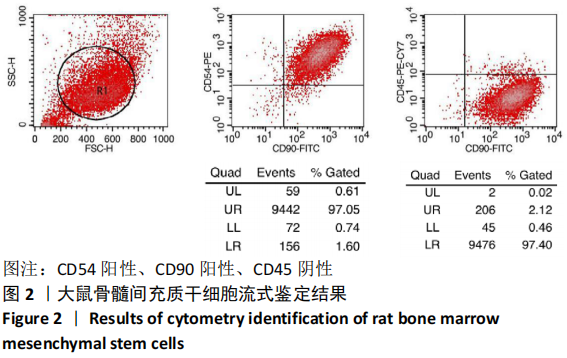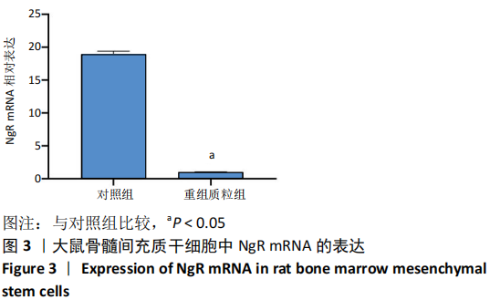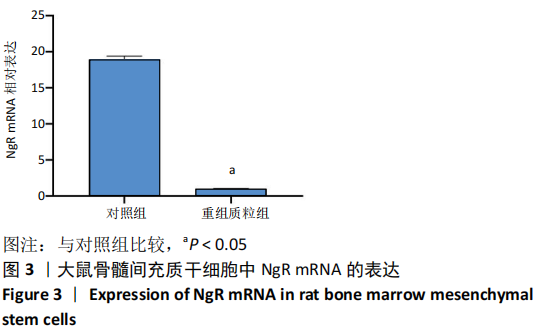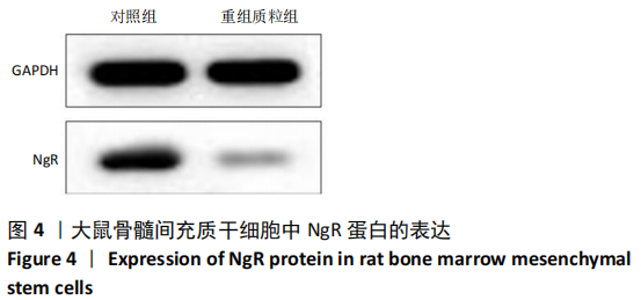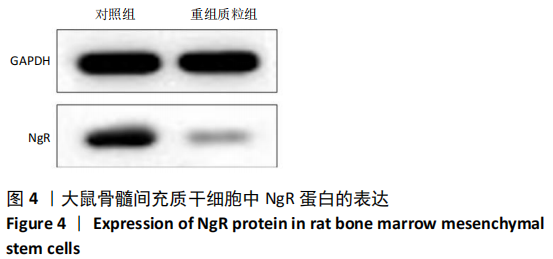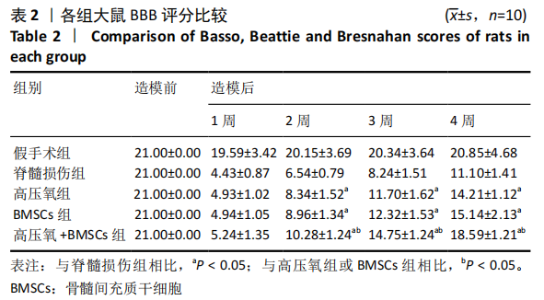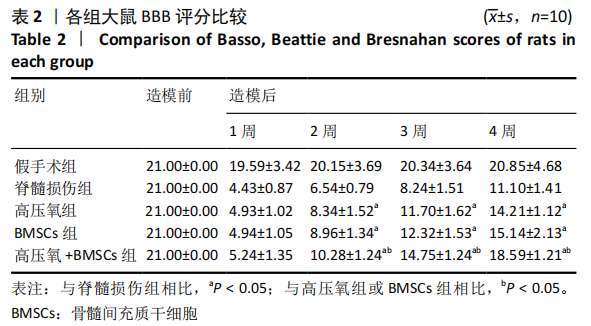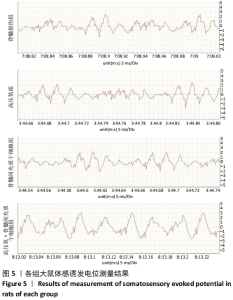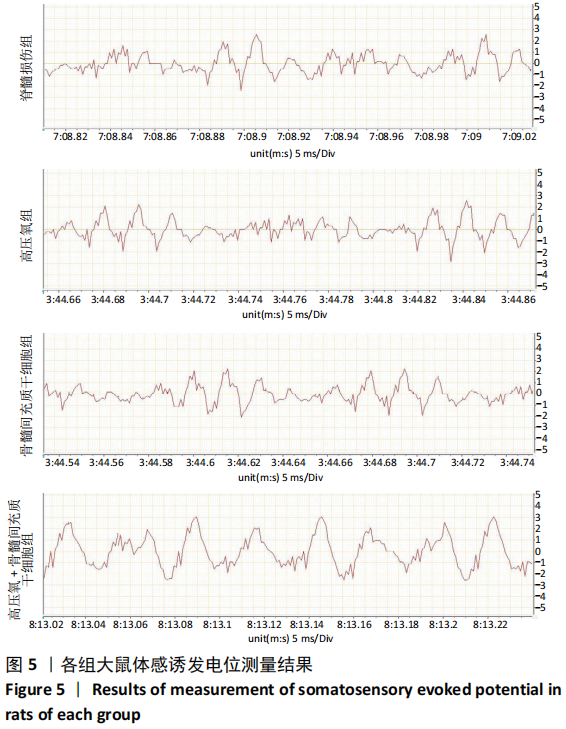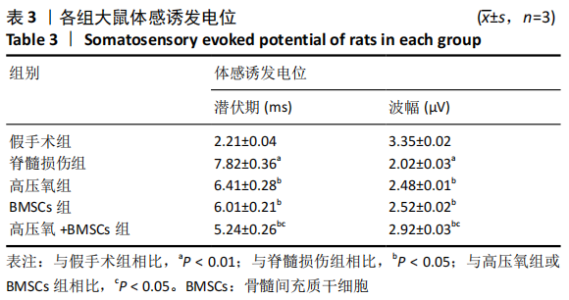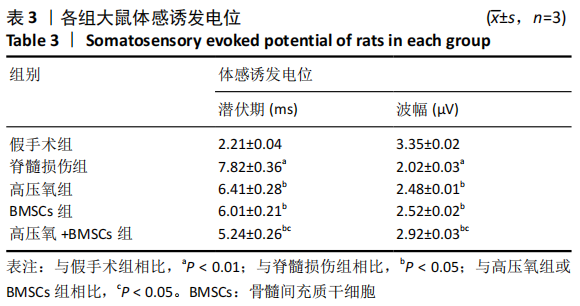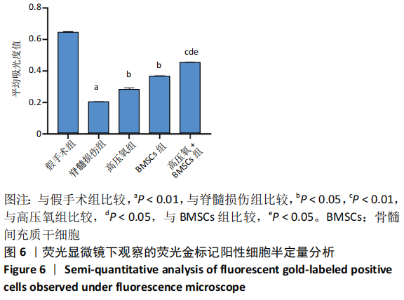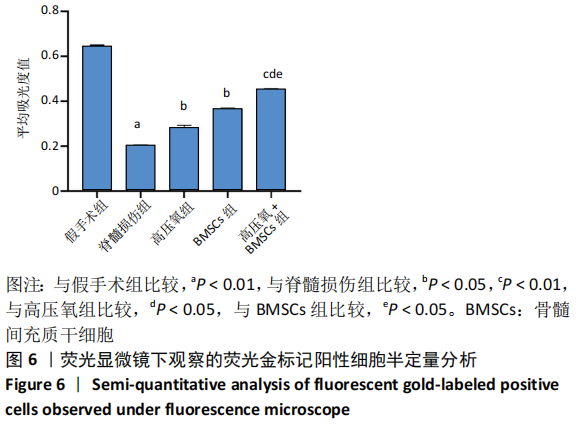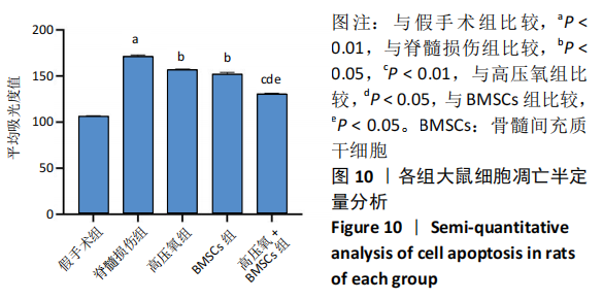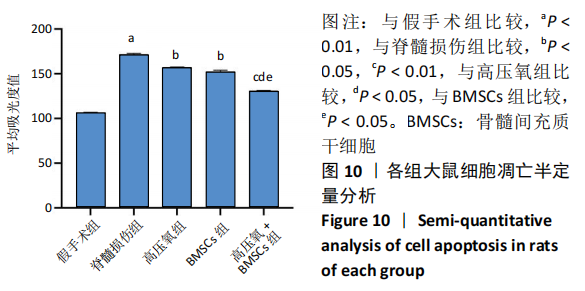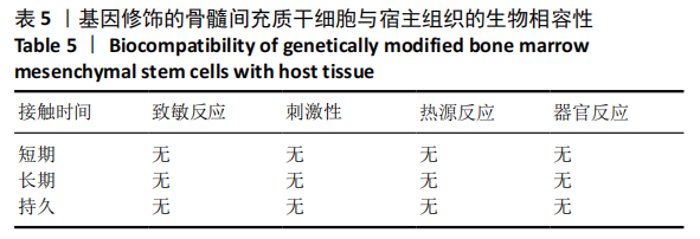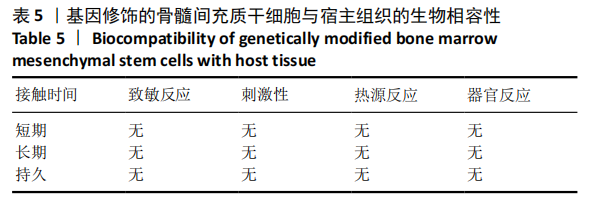Chinese Journal of Tissue Engineering Research ›› 2022, Vol. 26 ›› Issue (1): 12-19.doi: 10.12307/2022.003
Previous Articles Next Articles
Hyperbaric oxygen combined with NgR gene silencing bone marrow mesenchymal stem cells transplantation for spinal cord injury in rats
Mei Yunyun1, Zhang Jianjun2, Wang Dong2
- 1Fourth Clinical College of Tianjin Medical University, Tianjin 300070, China; 2Tianjin Fourth Central Hospital, Tianjin 300140, China
-
Received:2020-10-15Revised:2020-10-17Accepted:2020-11-21Online:2022-01-08Published:2021-10-23 -
Contact:Wang Dong, Chief physician, Master’s supervisor, Tianjin Fourth Central Hospital, Tianjin 300140, China -
About author:Mei Yunyun, Master candidate, Fourth Clinical College of Tianjin Medical University, Tianjin 300070, China
CLC Number:
Cite this article
Mei Yunyun, Zhang Jianjun, Wang Dong. Hyperbaric oxygen combined with NgR gene silencing bone marrow mesenchymal stem cells transplantation for spinal cord injury in rats[J]. Chinese Journal of Tissue Engineering Research, 2022, 26(1): 12-19.
share this article
Add to citation manager EndNote|Reference Manager|ProCite|BibTeX|RefWorks
| [1] COURTINE G, SOFRONIEW MV. Spinal cord repair: advances in biology and technology. Nat Med. 2019;25(6):898-908. [2] RAYNALD, LI Y, YU H, et al. The hetero-transplantation of human bone marrow stromal cells carried by hydrogel unexpectedly demonstrates a significant role in the functional recovery in the injured spinal cord of rats. Brain Res. 2016;1634:21-33. [3] NEIRINCKX V, AGIRMAN G, COSTE C, et al. Adult bone marrow mesenchymal and neural crest stem cells are chemoattractive and accelerate motor recovery in a mouse model of spinal cord injury. Stem Cell Res Ther. 2015;6:211. [4] LIN L, LIN H, BAI S, et al. Bone marrow mesenchymal stem cells (BMSCs) improved functional recovery of spinal cord injury partly by promoting axonal regeneration. Neurochem Int. 2018;115:80-84. [5] LEE SH, KIM Y, RHEW D, et al. Effect of the combination of mesenchymal stromal cells and chondroitinase ABC on chronic spinal cord injury. Cytotherapy. 2015;17(10):1374-1383. [6] REGINENSI D, CARULLA P, NOCENTINI S, et al. Increased migration of olfactory ensheathing cells secreting the Nogo receptor ectodomain over inhibitory substrates and lesioned spinal cord. Cell Mol Life Sci. 2015;72(14):2719-2737. [7] PATEL NP, HUANG JH. Hyperbaric oxygen therapy of spinal cord injury. Med Gas Res. 2017;7(2):133-143. [8] GENG CK, CAO HH, YING X, et al. Effect of mesenchymal stem cells transplantation combining with hyperbaric oxygen therapy on rehabilitation of rat spinal cord injury. Asian Pac J Trop Med. 2015;8(6): 468-473. [9] 李超,付红杰,张建军,等.亚低温干预下神经干细胞的RhoA/ROCK通路[J].中国组织工程研究,2017,21(13):2094-2099. [10] AHUJA CS, MOTHE A, KHAZAEI M, et al. The leading edge: Emerging neuroprotective and neuroregenerative cell-based therapies for spinal cord injury. Stem Cells Transl Med. 2020;9(12):1509-1530. [11] LE BLANC K, PITTENGER M. Mesenchymal stem cells: progress toward promise. Cytotherapy. 2005;7(1):36-45. [12] DAY P, ALVES N, DANIELL E, et al. Targeting chondroitinase ABC to axons enhances the ability of chondroitinase to promote neurite outgrowth and sprouting. PLoS One. 2020;15(1):e0221851. [13] ORR MB, GENSEL JC. Spinal Cord Injury Scarring and Inflammation: Therapies Targeting Glial and Inflammatory Responses. Neurotherapeutics. 2018;15(3):541-553. [14] QURAISHE S, FORBES LH, ANDREWS MR. The Extracellular Environment of the CNS: Influence on Plasticity, Sprouting, and Axonal Regeneration after Spinal Cord Injury. Neural Plast. 2018;2018:2952386. [15] HUANG LJ, LI G, DING Y, et al. LINGO-1 deficiency promotes nerve regeneration through reduction of cell apoptosis, inflammation, and glial scar after spinal cord injury in mice. Exp Neurol. 2019;320:112965. [16] TRAN AP, WARREN PM, SILVER J. The Biology of Regeneration Failure and Success After Spinal Cord Injury. Physiol Rev. 2018;98(2):881-917. [17] UENO R, TAKASE H, SUENAGA J, et al. Axonal regeneration and functional recovery driven by endogenous Nogo receptor antagonist LOTUS in a rat model of unilateral pyramidotomy. Exp Neurol. 2020; 323:113068. [18] JIANG JP, LIU XY, ZHAO F, et al. Three-dimensional bioprinting collagen/silk fibroin scaffold combined with neural stem cells promotes nerve regeneration after spinal cord injury. Neural Regen Res. 2020;15(5): 959-968. [19] WANG X, HU J, SHE Y, et al. Cortical PKC inhibition promotes axonal regeneration of the corticospinal tract and forelimb functional recovery after cervical dorsal spinal hemisection in adult rats. Cereb Cortex. 2014;24(11):3069-3079. [20] LU XM, WEI JX, XIAO L, et al. Experimental and Clinical Advances in Immunotherapy Strategies for Spinal Cord Injury Target on MAIs and Their Receptors. Curr Pharm Des. 2016;22(6):728-737. [21] WANG YT, LU XM, ZHU F, et al. Ameliorative Effects of p75NTR-ED-Fc on Axonal Regeneration and Functional Recovery in Spinal Cord-Injured Rats. Mol Neurobiol. 2015;52(3):1821-1834. [22] ALMUTIRI S, BERRY M, LOGAN A, et al. Non-viral-mediated suppression of AMIGO3 promotes disinhibited NT3-mediated regeneration of spinal cord dorsal column axons. Sci Rep. 2018;8(1):10707. [23] LÜ BT, YUAN W, XU SM. Lentiviral vector-mediated RNA interfere gene Nogo receptor to repair spinal cord injury. Zhonghua Wai Ke Za Zhi. 2010;48(20):1573-1576. [24] XU J, HE J, HE H, et al. Comparison of RNAi NgR and NEP1-40 in Acting on Axonal Regeneration After Spinal Cord Injury in Rat Models. Mol Neurobiol. 2017;54(10):8321-8331. [25] WANG D, FAN Y, ZHANG J. Transplantation of Nogo-66 receptor gene-silenced cells in a poly(D,L-lactic-co-glycolic acid) scaffold for the treatment of spinal cord injury. Neural Regen Res. 2013;8(8):677-685. [26] ZHAO X, PENG Z, LONG L, et al. Lentiviral vector delivery of short hairpin RNA to NgR1 promotes nerve regeneration and locomotor recovery in injured rat spinal cord. Sci Rep. 2018;8(1):5447. [27] CHEN N, CEN JS, WANG J, et al. Targeted Inhibition of Leucine-Rich Repeat and Immunoglobulin Domain-Containing Protein 1 in Transplanted Neural Stem Cells Promotes Neuronal Differentiation and Functional Recovery in Rats Subjected to Spinal Cord Injury. Crit Care Med. 2016;44(3):e146-157. [28] WANG D, LIANG J, ZHANG J, et al. Mild hypothermia combined with a scaffold of NgR-silenced neural stem cells/Schwann cells to treat spinal cord injury. Neural Regen Res. 2014;9(24):2189-2196. [29] LI Z, ZHANG Z, ZHAO L, et al. Bone marrow mesenchymal stem cells with Nogo-66 receptor gene silencing for repair of spinal cord injury. Neural Regen Res. 2014;9(8):806-814. [30] GARDIN C, BOSCO G, FERRONI L, et al. Hyperbaric Oxygen Therapy Improves the Osteogenic and Vasculogenic Properties of Mesenchymal Stem Cells in the Presence of Inflammation In Vitro. Int J Mol Sci. 2020;21(4):1452. [31] WANG B, XIAO Z, CHEN B, et al. Nogo-66 promotes the differentiation of neural progenitors into astroglial lineage cells through mTOR-STAT3 pathway. PLoS One. 2008;3(3):e1856. [32] LI X, FU QL, JING XL, et al. Myelin-associated glycoprotein inhibits the neuronal differentiation of neural progenitors. Neuroreport. 2009;20(7):708-712. [33] ROLANDO C, PAROLISI R, BODA E, et al. Distinct roles of Nogo-a and Nogo receptor 1 in the homeostatic regulation of adult neural stem cell function and neuroblast migration. J Neurosci. 2012;32(49): 17788-17799. [34] 孙师,张立新,张志强.骨髓间充质干细胞移植对脊髓损伤后轴突再生及Nogo-A蛋白表达的影响[J].解剖学杂志,2016,39(2):229-232. [35] 杨俊锋,张亚峰,马勇,等.大鼠脊髓损伤后勿动蛋白受体的动态表达[J].中国康复理论与实践,2014,20(10):919-923. [36] KANG X, WEN J, WANG X, et al. Temporal and spatial pattern of RhoA expression in injured spinal cord of adult mice. Nan Fang Yi Ke Da Xue Xue Bao. 2013;33(4):463-468.
(责任编辑:MZH,ZN,JY)
|
| [1] | Wang Jing, Xiong Shan, Cao Jin, Feng Linwei, Wang Xin. Role and mechanism of interleukin-3 in bone metabolism [J]. Chinese Journal of Tissue Engineering Research, 2022, 26(8): 1316-1322. |
| [2] | Xiao Hao, Liu Jing, Zhou Jun. Research progress of pulsed electromagnetic field in the treatment of postmenopausal osteoporosis [J]. Chinese Journal of Tissue Engineering Research, 2022, 26(8): 1323-1329. |
| [3] | Kan Houming, Fan Lijun, Chen Xuetai, Shen Wen. Application of platelet-rich plasma in neuropathic pain [J]. Chinese Journal of Tissue Engineering Research, 2022, 26(8): 1345-1353. |
| [4] | Liu Gang, Ma Chao, Wang Le, Zeng Jie, Jiao Yong, Zhao Yi, Ren Jingpei, Hu Chuanyu, Xu Lin, Mu Xiaohong. Ankle-foot orthoses improve motor function of children with cerebral palsy: a Meta-analysis based on 12 randomized controlled trials [J]. Chinese Journal of Tissue Engineering Research, 2022, 26(8): 1361-1367. |
| [5] | An Weizheng, He Xiao, Ren Shuai, Liu Jianyu. Potential of muscle-derived stem cells in peripheral nerve regeneration [J]. Chinese Journal of Tissue Engineering Research, 2022, 26(7): 1183-1190. |
| [6] | Fan Yiming, Liu Fangyu, Zhang Hongyu, Li Shuai, Wang Yansong. Serial questions about endogenous neural stem cell response in the ependymal zone after spinal cord injury [J]. Chinese Journal of Tissue Engineering Research, 2022, 26(7): 1191-1197. |
| [7] | Tian Chuan, Zhu Xiangqing, Yang Zailing, Yan Donghai, Li Ye, Wang Yanying, Yang Yukun, He Jie, Lü Guanke, Cai Xuemin, Shu Liping, He Zhixu, Pan Xinghua. Bone marrow mesenchymal stem cells regulate ovarian aging in macaques [J]. Chinese Journal of Tissue Engineering Research, 2022, 26(7): 1033-1039. |
| [8] | Hu Wei, Xie Xingqi, Tu Guanjun. Exosomes derived from bone marrow mesenchymal stem cells improve the integrity of the blood-spinal cord barrier after spinal cord injury [J]. Chinese Journal of Tissue Engineering Research, 2022, 26(7): 1040-1046. |
| [9] | Hou Jingying, Guo Tianzhu, Yu Menglei, Long Huibao, Wu Hao. Hypoxia preconditioning targets and downregulates miR-195 and promotes bone marrow mesenchymal stem cell survival and pro-angiogenic potential by activating MALAT1 [J]. Chinese Journal of Tissue Engineering Research, 2022, 26(7): 1053-1059. |
| [10] | Zhou Ying, Zhang Huan, Liao Song, Hu Fanqi, Yi Jing, Liu Yubin, Jin Jide. Immunomodulatory effects of deferoxamine and interferon gamma on human dental pulp stem cells [J]. Chinese Journal of Tissue Engineering Research, 2022, 26(7): 1060-1067. |
| [11] | Liang Xuezhen, Yang Xi, Li Jiacheng, Luo Di, Xu Bo, Li Gang. Bushen Huoxue capsule regulates osteogenic and adipogenic differentiation of rat bone marrow mesenchymal stem cells via Hedgehog signaling pathway [J]. Chinese Journal of Tissue Engineering Research, 2022, 26(7): 1068-1074. |
| [12] | Wang Jifang, Bao Zhen, Qiao Yahong. miR-206 regulates EVI1 gene expression and cell biological behavior in stem cells of small cell lung cancer [J]. Chinese Journal of Tissue Engineering Research, 2022, 26(7): 1075-1079. |
| [13] | Liu Feng, Peng Yuhuan, Luo Liangping, Wu Benqing. Plant-derived basic fibroblast growth factor maintains the growth and differentiation of human embryonic stem cells [J]. Chinese Journal of Tissue Engineering Research, 2022, 26(7): 1080-1085. |
| [14] | Wen Dandan, Li Qiang, Shen Caiqi, Ji Zhe, Jin Peisheng. Nocardia rubra cell wall skeleton for extemal use improves the viability of adipogenic mesenchymal stem cells and promotes diabetes wound repair [J]. Chinese Journal of Tissue Engineering Research, 2022, 26(7): 1086-1092. |
| [15] | Zhu Bingbing, Deng Jianghua, Chen Jingjing, Mu Xiaoling. Interleukin-8 receptor enhances the migration and adhesion of umbilical cord mesenchymal stem cells to injured endothelium [J]. Chinese Journal of Tissue Engineering Research, 2022, 26(7): 1093-1098. |
| Viewed | ||||||
|
Full text |
|
|||||
|
Abstract |
|
|||||
